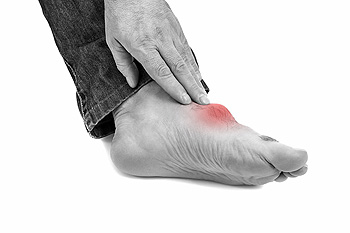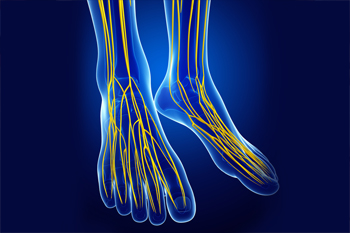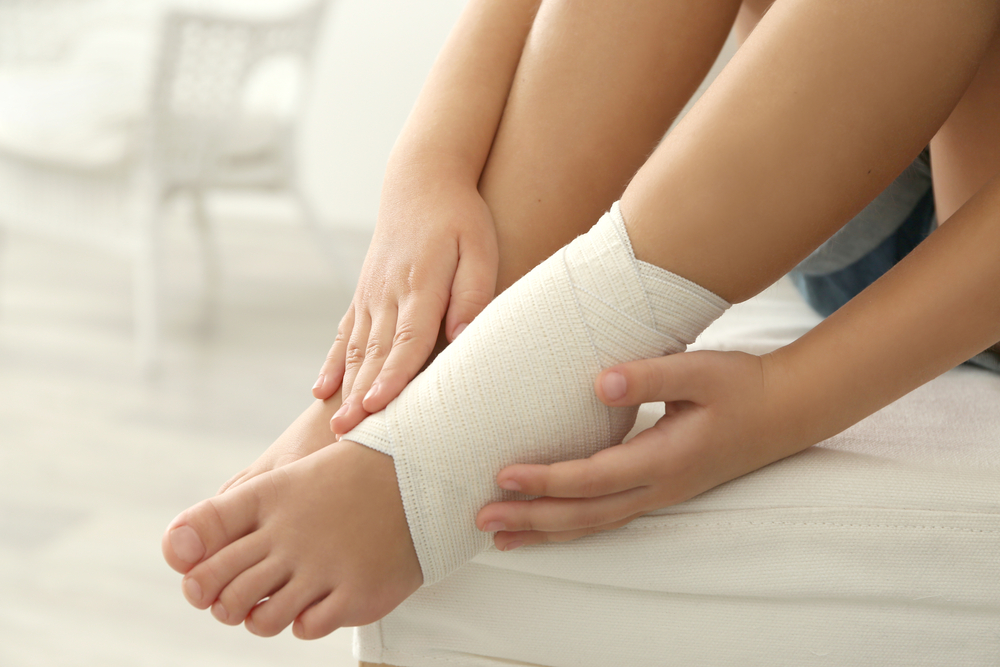Items filtered by date: April 2021
Heel Pain Can Be Treated!
Why Ankles Are so Important to Mobility
The ankle is a joint that connects the leg to the foot using a series of bones including the fibula, tibia, and the tarsal bones of the foot. The ankle is an integral part of a complex system that continually keeps our bodies balanced when we stand, and aids in our overall mobility. The foot needs the ankle in order to move up and down (dorsiflexion and plantarflexion), side-to-side (inversion and eversion), and to rotate either inward or outward (medially and laterally). Because of how active the ankle is in everyday movements as well as athletic activities, ankle injuries are quite common. Additionally, as we age, ankle mobility declines and makes us more prone to falling and other accidents. If you are experiencing any type of issue with your ankle, contact a podiatrist who can examine you and perform a variety of tests to detect any underlying cause of ankle pain, weakness, or mobility deterioration.
Foot and ankle trauma is common among athletes and the elderly. If you have concerns that you may have experienced trauma to the foot and ankle, consult with Donald Manger, DPM from Associated Podiatric Physicians, PA. Our doctor will assess your condition and provide you with quality foot and ankle treatment.
Foot and ankle trauma cover a range of injuries all over the foot; common injuries include:
- Broken bones
- Muscle strains
- Injuries to the tendons and ligaments
- Stress fractures
Symptoms
Symptoms of foot and ankle injuries vary depending on the injury, but more common ones include:
- Bruising
- Inflammation/ Swelling
- Pain
Diagnosis
To properly diagnose the exact type of injury, podiatrists will conduct a number of different tests. Some of these include sensation and visual tests, X-rays, and MRIs. Medical and family histories will also be taken into account.
Treatment
Once the injury has been diagnosed, the podiatrist can than offer the best treatment options for you. In less severe cases, rest and keeping pressure off the foot may be all that’s necessary. Orthotics, such as a specially made shoes, or immobilization devices, like splints or casts, may be deemed necessary. Finally, if the injury is severe enough, surgery may be necessary.
If you have any questions, please feel free to contact our office located in Hamilton Township, NJ . We offer the newest diagnostic and treatment technologies for all your foot care needs.
What Does the Acronym PAD Stand For?
Peripheral Artery Disease (PAD) is a restriction of blood flow to the muscles and organs due to the build-up of plaque on artery walls. PAD starves muscles and organs of the oxygen and nutrients they need to function properly—especially during physical activities. This lack of oxygen-rich blood to the extremities can make it difficult to walk and can also cause pain in the feet and legs. This pain from PAD can go undetected in people who also suffer from diabetes and neuropathy, possibly leading to foot sores which—when caused by severe blood flow reduction—can increase the risk of amputation. Individuals who are afflicted with PAD and/or diabetes should be under the care of a podiatrist who can help to manage these conditions and improve overall health.
Peripheral artery disease can pose a serious risk to your health. It can increase the risk of stroke and heart attack. If you have symptoms of peripheral artery disease, consult with Donald Manger, DPM from Associated Podiatric Physicians, PA. Our doctor will assess your condition and provide you with quality foot and ankle treatment.
Peripheral artery disease (PAD) is when arteries are constricted due to plaque (fatty deposits) build-up. This results in less blood flow to the legs and other extremities. The main cause of PAD is atherosclerosis, in which plaque builds up in the arteries.
Symptoms
Symptoms of PAD include:
- Claudication (leg pain from walking)
- Numbness in legs
- Decrease in growth of leg hair and toenails
- Paleness of the skin
- Erectile dysfunction
- Sores and wounds on legs and feet that won’t heal
- Coldness in one leg
It is important to note that a majority of individuals never show any symptoms of PAD.
Diagnosis
While PAD occurs in the legs and arteries, Podiatrists can diagnose PAD. Podiatrists utilize a test called an ankle-brachial index (ABI). An ABI test compares blood pressure in your arm to you ankle to see if any abnormality occurs. Ultrasound and imaging devices may also be used.
Treatment
Fortunately, lifestyle changes such as maintaining a healthy diet, exercising, managing cholesterol and blood sugar levels, and quitting smoking, can all treat PAD. Medications that prevent clots from occurring can be prescribed. Finally, in some cases, surgery may be recommended.
If you have any questions, please feel free to contact our office located in Hamilton Township, NJ . We offer the newest diagnostic and treatment technologies for all your foot care needs.
Gout Can Produce Extreme Pain
 The most common form of inflammatory arthritis is referred to as gout. It is a condition that affects approximately four percent of Americans, and can be caused by genetic factors and eating habits. Common symptoms of this foot condition can include extreme tenderness, debilitating pain in the joints of the big toe, possibly causing difficulty in walking, and the toe may appear to be swollen. Some of the foods that can cause gout to develop include shellfish, red meat, and drinks that are made with large amounts of sugar. The pain comes from excess uric acid caused by elevated purine amounts that form in the joints, and can produce sensations that can feel like crystals in the feet. Mild relief may be found when lifestyle changes occur that include reducing the amount of food that is eaten with high purine levels. If you have frequent gout attacks, it is strongly advised that you are under the care of a podiatrist who can help you with proper treatment and prevention options.
The most common form of inflammatory arthritis is referred to as gout. It is a condition that affects approximately four percent of Americans, and can be caused by genetic factors and eating habits. Common symptoms of this foot condition can include extreme tenderness, debilitating pain in the joints of the big toe, possibly causing difficulty in walking, and the toe may appear to be swollen. Some of the foods that can cause gout to develop include shellfish, red meat, and drinks that are made with large amounts of sugar. The pain comes from excess uric acid caused by elevated purine amounts that form in the joints, and can produce sensations that can feel like crystals in the feet. Mild relief may be found when lifestyle changes occur that include reducing the amount of food that is eaten with high purine levels. If you have frequent gout attacks, it is strongly advised that you are under the care of a podiatrist who can help you with proper treatment and prevention options.
Gout is a painful condition that can be treated. If you are seeking treatment, contact Donald Manger, DPM from Associated Podiatric Physicians, PA. Our doctor will treat your foot and ankle needs.
What Is Gout?
Gout is a form of arthritis that is characterized by sudden, severe attacks of pain, redness, and tenderness in the joints. The condition usually affects the joint at the base of the big toe. A gout attack can occur at any random time, such as the middle of the night while you are asleep.
Symptoms
- Intense Joint Pain - Usually around the large joint of your big toe, and it most severe within the first four to twelve hours
- Lingering Discomfort - Joint discomfort may last from a few days to a few weeks
- Inflammation and Redness -Affected joints may become swollen, tender, warm and red
- Limited Range of Motion - May experience a decrease in joint mobility
Risk Factors
- Genetics - If family members have gout, you’re more likely to have it
- Medications - Diuretic medications can raise uric acid levels
- Gender/Age - Gout is more common in men until the age of 60. It is believed that estrogen protects women until that point
- Diet - Eating red meat and shellfish increases your risk
- Alcohol - Having more than two alcoholic drinks per day increases your risk
- Obesity - Obese people are at a higher risk for gout
Prior to visiting your podiatrist to receive treatment for gout, there are a few things you should do beforehand. If you have gout you should write down your symptoms--including when they started and how often you experience them, important medical information you may have, and any questions you may have. Writing down these three things will help your podiatrist in assessing your specific situation so that he or she may provide the best route of treatment for you.
If you have any questions, please feel free to contact our office located in Hamilton Township, NJ . We offer the newest diagnostic and treatment technologies for all your foot care needs.
Why Does My Ankle Feel Weak?
Repeated ankle sprains that have not healed nor been properly rehabilitated can cause chronic ankle instability—a condition where the ankle becomes weakened, uncomfortable, swollen, unstable, and is prone to roll outward. While this occurrence typically happens during activities or walking, it can also happen just by standing. A podiatrist can determine the proper treatment of a chronically unstable ankle depending upon what an examination reveals and the level of activity of the patient. Treatments may include exercises to strengthen muscles, increase range of motion and improve balance, as well as bracing, medication, and even surgery if the patient does not respond to non-surgical methods.
Ankle sprains are common but need immediate attention. If you need your feet checked, contact Donald Manger, DPM from Associated Podiatric Physicians, PA. Our doctor can provide the care you need to keep you pain-free and on your feet.
How Does an Ankle Sprain Occur?
Ankle sprains take place when the ligaments in your ankle are torn or stretched beyond their limits. There are multiple ways that the ankle can become injured, including twisting or rolling over onto your ankle, putting undue stress on it, or causing trauma to the ankle itself.
What Are the Symptoms?
- Mild to moderate bruising
- Limited mobility
- Swelling
- Discoloration of the skin (depending on severity)
Preventing a Sprain
- Wearing appropriate shoes for the occasion
- Stretching before exercises and sports
- Knowing your limits
Treatment of a Sprain
Treatment of a sprain depends on the severity. Many times, people are told to rest and remain off their feet completely, while others are given an air cast. If the sprain is very severe, surgery may be required.
If you have suffered an ankle sprain previously, you may want to consider additional support such as a brace and regular exercises to strengthen the ankle.
If you have any questions please feel free to contact our office located in Hamilton Township, NJ . We offer the newest diagnostic and treatment technologies for all your foot and ankle needs.




